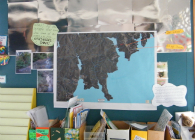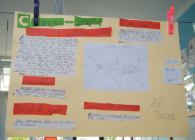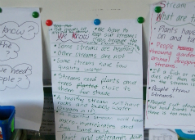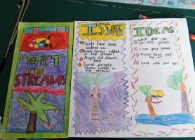Session 6
Learning Outcomes
At the end of the session students will be able to …
1. identify actions they can take to help protect waterways
2. reflect on the outcome of their actions
Resources
Enviroschools kit Action Tools pages 218 – 226 (see also Poorman Stream case study in this section –‘The River Rockets’); Reflect pages 250 – 274
Take action for Water http://www.gw.govt.nz/assets/Get-Involved/TAFW-TakeActionsection.PDF
Curriculum links
Key competencies
• Thinking
• Participating and contributing
• Relating to others
Social Sciences, Technology, Science, English, Drama, Visual Arts
Activities
1. Stream environmental team/s
Plan how your class/ school could organise project/s to save your stream.
The whole class could look at a range of possible actions and choose one or the class could be divided to work on their own action plan. eg A third of the class could look at a ‘no cost’ project, a third a ‘low cost’ project and the other third a ‘high cost’ project (this would require partners or fundraising).
Step 1:
How could our project help to save our stream?
Students could use the following to help them decide on their project/s based on their learning from the past few weeks:
|
What are the main issues of concern? |
Can we take action to solve this issue? Yes or no? |
How can we take action to improve the issue? |
Step 2:
How would it involve students / people in the community? Who else will we need to involve? Who will do what?
Step 3:
How much time and money would it involve? Where would we get money/ resources from? What is the timeframe for the project? Fundraising ideas, support from Council and local businesses
Step 4:
How could we make it fun to get lots of people involved? How could we let lots of people know what we are doing and why? (eg information day to educate the community, other schools, design a stream trail / treasure hunt – displays, fliers, survey, produce a play, news stories for local newspaper, school website & newsletters)
Step 5:
Prepare a presentation of your project giving the above details … using pictures, diagrams, collage, songs, skits, raps, poems, PowerPoint
Step 6:
Invite your local Councillor, someone from your local board or someone from the contact list above (Project Twin Streams, etc) to come to your school so you can present your stream project/s.
Step 7:
Present to the school at assembly.
Step 8:
TAKE ACTION!!!
Laingholm School Years 3 – 6 classes came up with the following action projects in 2009 and 2010. Each class chose a different action:
• Wall charts
• Brochures
• Fliers (put in letterboxes)
• Posters
• A big book produced and presented to local kindergarten
• Set up a parent action group (sustainable neighbourhood group)
• Set up a planting group (Year 5/6 students)
Assessment
• Reflection
Revisit your big inquiry question (session 1) and complete the KWL chart (what I Know, what I Want to know, what I have Learned).
1. What have we done and what have we achieved? Storyboard, learning log, site map, photos
2. How did the project go? Was it successful? What worked? What didn’t? Why? What would we do differently next time?
3. What changes and benefits have come about because of our actions? So what? What does this mean for us and for others? How can we measure change?
4. How will we celebrate our achievements?
5. Where to from here? What now? What are our next steps? How could we extend or improve our action project?
 |
 |
 |
| Session 1 Up the Creek |
Session 2 Wai … it goes round and round |
Session 3 Oh for a cool stream! |
 |
 |
 |
| Session 4 Hey! Watch where you chuck your muck! |
Session 5 Time to Come Clean |
Session 6 We’re Scheming for a Clean Stream |

